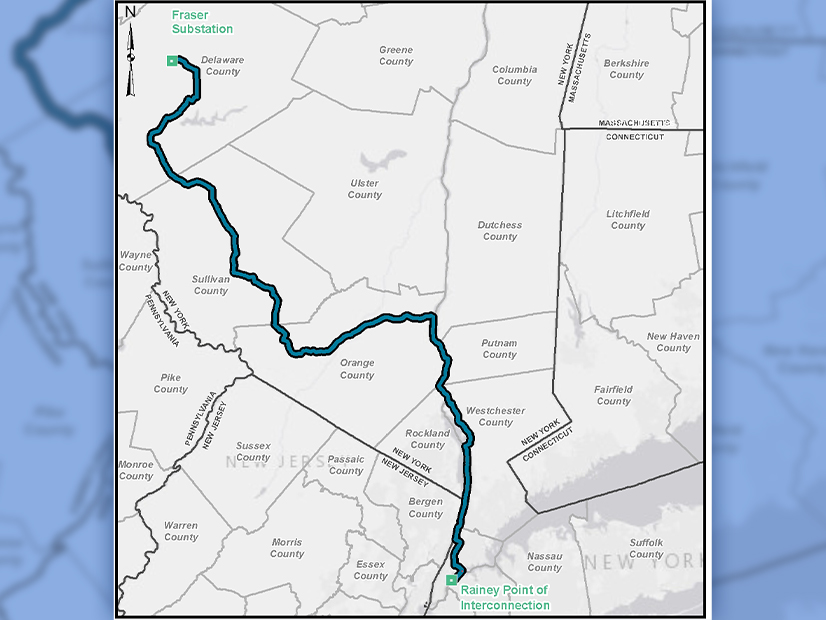
An $11 billion package of transmission and renewable energy investments planned in New York has been canceled.
The Clean Path New York (CPNY) renewable energy certificate (REC) contract with the state was terminated Nov. 27, and one of the partners in the venture said Dec. 2 the project itself has been abandoned.
No reason was stated for the cancellation, but CPNY likely encountered the same delays and cost escalations that have bedeviled other energy projects in New York.
CPNY was envisioned as a way to break the densely populated New York City region’s heavy reliance on aging fossil fuel power generation.
It was to transmit 3.8 GW of power from 23 new solar and onshore wind projects in rural upstate New York south to the New York City area via a 175-mile underground HVDC line.
Public- and private-sector officials announced in November 2021 that CPNY and the Champlain Hudson Power Express had been chosen for the new Tier 4 RECs designed to help decarbonize the downstate grid.
After more than a decade in development, and with an expected price tag now in the $6 billion range, Champlain Hudson is under construction. (See Champlain Hudson Power Project Receives Landmark Delivery.) CPNY, which had expected to start construction in 2024 and enter service in 2027, had not yet been approved.
CPNY was a public-private collaboration of the New York Power Authority (NYPA) and Forward Power, which is a joint venture of energyRe and Invenergy.
New York State Energy Research and Development Authority (NYSERDA) notified the Department of Public Service on Nov. 27 that it and CPNY by mutual agreement had terminated the Tier 4 REC contract (Case 15-E-0302).
The three-sentence notice provided no details, and neither did NYPA or Forward.
NYPA Vice President of Corporate Communications Lindsay Kryzak said Dec. 2 via email: “The Clean Path project was a public-private collaboration in response to the Tier 4 RFP by NYSERDA. We worked alongside energyRE and Invenergy to continue moving Clean Path forward in the face of changing conditions related to the economics of the project. NYPA will continue to work on modernizing the grid and addressing New York State’s transmission needs to support its long-term goals.”
Forward Power spokesperson Amy Varghese said via email: “energyRe and Invenergy remain committed to New York’s energy transition. As we continue to advance our portfolio of renewable energy projects across the state, we will evaluate solutions for addressing the largest transmission bottlenecks facing New York’s electric grid in order to deliver reliable and affordable power, good-paying jobs and clean air for the Empire State.”
CPNY is the latest in a long series of casualties in New York’s legally mandated effort to green its grid.
In June 2023, the developers of most of New York’s large-scale onshore and offshore renewable energy proposals sought to renegotiate their REC contracts because the cost of construction had soared after they locked in their compensation with the contracts. (See OSW Developers Seeking More Money from New York.)
CPNY followed up with a petition for more money as well, arguing that it was facing the same economic pinch: 14 of the proposals that made up the generation side of the portfolio already held Tier 1 REC contracts, and the other nine were Tier 1-eligible. (See Clean Path NY Joins Calls for Inflation Adjustment.)
The Public Service Commission rejected the developers’ request to renegotiate the contracts in October 2023 and CPNY subsequently withdrew its petition. (See NY Rejects Inflation Adjustment for Renewable Projects.)
Developers soon canceled the bulk of the REC contracts New York had signed. They were allowed to rebid their projects into subsequent solicitations, but the state’s portfolio of contracted renewables remains stunted a year later, and state officials expect to miss the 70% renewables by 2030 mandate, perhaps by a wide margin. (See NY Expects to Miss 2030 Renewable Energy Target.)
Varghese did not provide a requested update on the status of the 23 generation proposals.
They were not a batch of new proposals drawn up for CPNY. Rather, they were a collection of pre-existing proposals gathered into the CPNY portfolio. And cancellation of a REC contract does not mean cancellation of the project itself, though it almost certainly pushes back the timeline.
Meanwhile, the complex Tier 4 mechanism itself is gradually taking shape. NYSERDA submitted an implementation plan Oct. 11, four years after Tier 4 was added to the state’s Clean Energy Standard.
And a new state law gave NYPA a new role as a renewable energy developer in mid-2023, more than a year after its CPNY collaboration was chosen for a Tier 4 contract.
NYPA is finalizing a strategic plan for 3.5 GW of wind, solar and storage capacity that it would develop on its own or in collaboration with the private sector. It has said the 40 proposals in the plan likely would suffer the same attrition rate as seen in the industry — 80 to 85% for early stage proposals and 30 to 60% for more mature projects. (See NYPA Enters Renewable Development with 3.5-GW Plan and NYPA Urged to Do More in New Renewables Role.)


